Last Updated: August 4, 2025
Long before ecotourism vans took to the roads of Costa Rica, there was another much simpler mode of transportation: the oxcart. Brightly painted with intricate designs, these original wagons or their replicas can be seen throughout the country in restaurants, businesses, and on the shelves of souvenir shops. This icon of Costa Rica was once used by farmers to transport goods like sugarcane and coffee beans. Today, in the town of Sarchi, they are still made in the traditional style. In this post, we’ll let you know how you can visit this charming town near San Jose and see these beautiful carts for yourself.
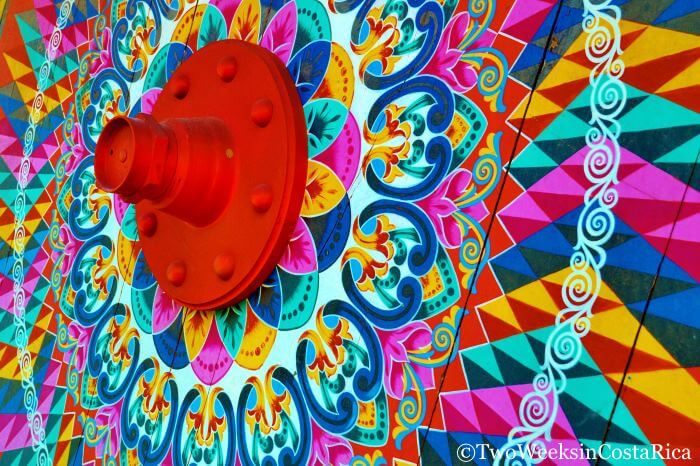
Sarchi, Costa Rica and Its History
Just 30 minutes northwest of the international airport near San Jose (SJO) is Costa Rica’s capital of oxcart production, Sarchi. You’ll know you’ve arrived thanks to the giant oxcart replica (the biggest in the world) right in the town’s central park.
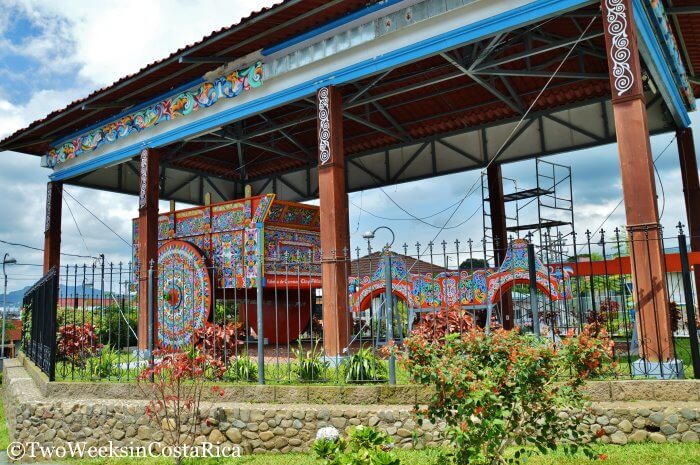
For over 100 years, farms in Costa Rica’s Central Valley have been producing some of the country’s best coffee. Needing a sturdy way to transport this precious cargo to ports on the coast, a demand for ox-drawn carts was born.
The earliest oxcarts of Sarchi date back to the late 1800s and were simple and functional. But as time went on, craftsmen began incorporating their own unique markings to distinguish their carts.
By the beginning of the 20th century, competition among artisans was strong, and carts were decorated with elaborate geometric patterns, similar to the designs that can be seen today.
In addition to Sarchi, oxcart makers in other towns around Costa Rica decorated their carts in a slightly different way. At one time, it was said that you could tell which specific towns were represented at a shipping port just by comparing the carts.
Visiting an Oxcart Manufacturer
Today there is still one factory in Sarchi that you can visit to see how oxcarts were traditionally made and painted.
Fabrica de Carretas Eloy Alfaro offers daily demonstrations and is a popular stop on any Costa Rica cultural tour.
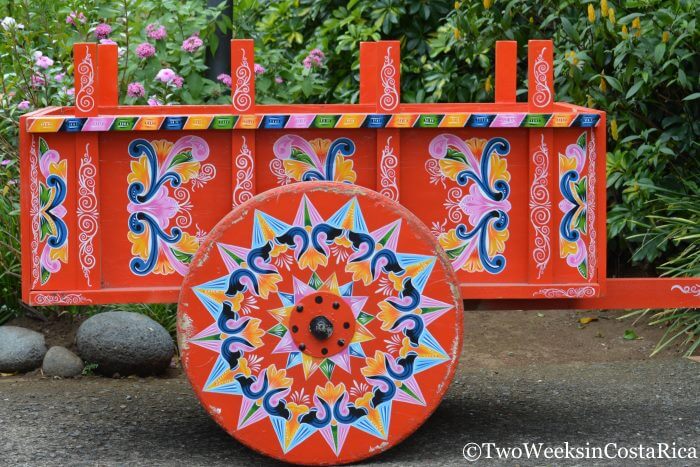
Oxcart Fabrication
At Fabrica de Carretas Eloy Alfaro, you can still find much of the original equipment that was used to make thousands of oxcarts over the years.
If you are a woodworker, this is your place. The small outdoor factory is positioned on a stream and uses a waterwheel to power much of the machinery. Although the equipment is dated, over the years there have been some upgrades. For example, in 1934, the large wheel was converted from wood to metal. It was upgraded again in 1965 to a stronger iron.
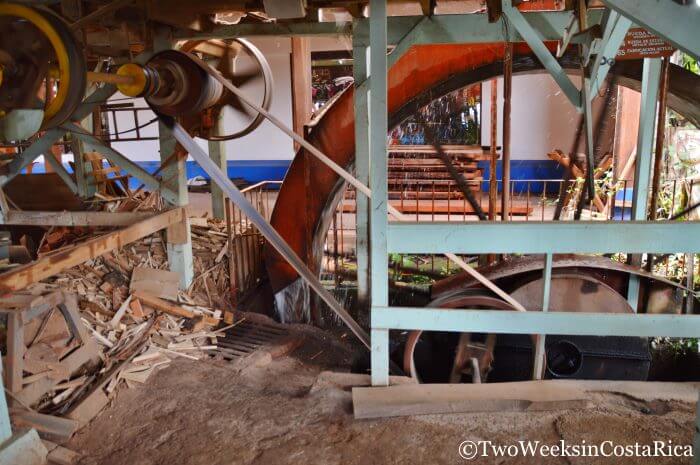
The most prominent part of any oxcart is the wheels. They are also the feature that is the most complex to build. Square and rigid pieces of wood like Spanish cedar, mahogany, and laurel are first stacked to dry. Then, when they are ready, each piece is carefully cut into the shape of a wedge.
Sixteen different wedges make up each circle and they are bound together with a heated metal ring to make a wheel. The wheels are then sanded smooth.
While watching the process, you’ll notice some large clunky belts spinning overhead, which connect the machinery to the waterwheel. These belts are what powers the table saw, sander, and any other tools needed by the craftsmen.
Once the wheels are complete, they are passed on to the artists who paint them.
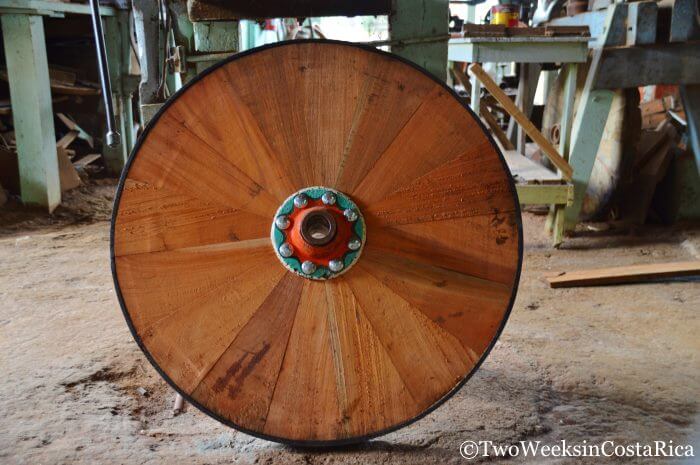
Painting an oxcart wheel isn’t as simple as it sounds, especially when the designs are so intricate. But just across from the wood shop at Eloy Alfaro are several painters who are continuing this tradition.
These talented individuals paint each detail by hand with narrow brushes. In addition to the wheels, they decorate all the other parts of the oxcart as well.
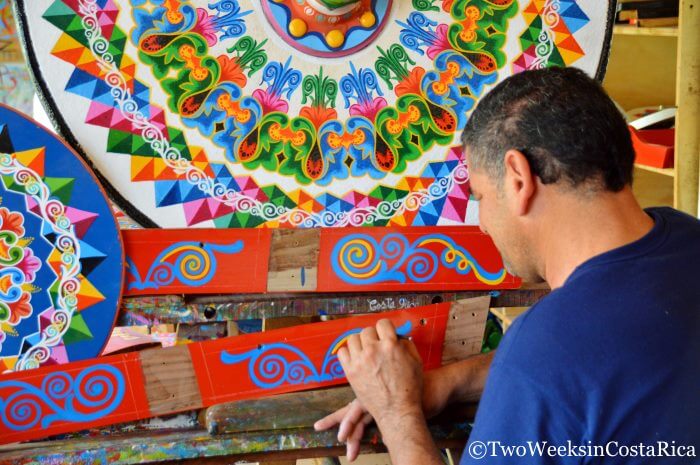
Other Artwork
Walking around Fabrica de Carretas Eloy Alfaro, you’ll see that the artists have painted just about every other surface in the place too.
One of our favorites was a replica of the Alegoría al Café y al Banano (Allegory of Coffee and Bananas) that is painted on a wall. The original of this mural can be found on the ceiling of the National Theater in San Jose. It’s a significant piece of Costa Rican cultural art, depicting the Port of Limón on the Caribbean coast with bananas and coffee being exported.
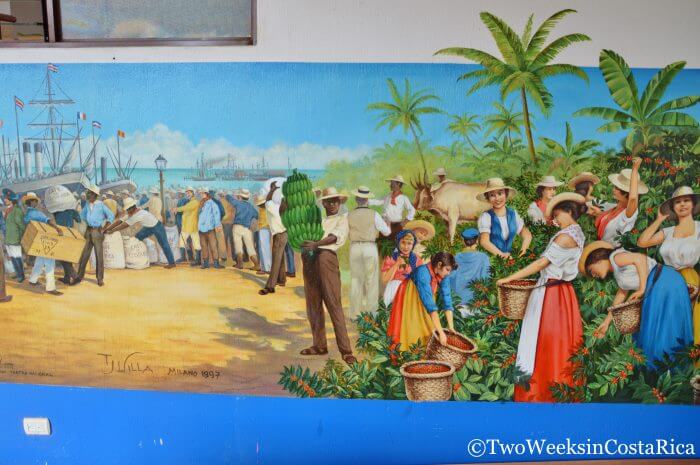
Gift Shop
After the demonstrations, you can also check out the huge gift shop for a keepsake. The shop has all the usual souvenirs like oxcart replicas, T-shirts, key chains, wooden bowls, and indigenous masks, but most interesting to us were the rocking chairs.
In addition to its oxcarts, Sarchi is also known for its furniture. All around town, you’ll find stores displaying beautiful wooden pieces from beds and bookcases to chests and dining sets and traditional rocking chairs.
The rocking chairs are made of native wood, have a leather seat and back that are often decorated in a traditional Costa Rican theme, and fold up nicely for transport/shipping. We actually bought one ourselves and love it! They do ship these worldwide as well.
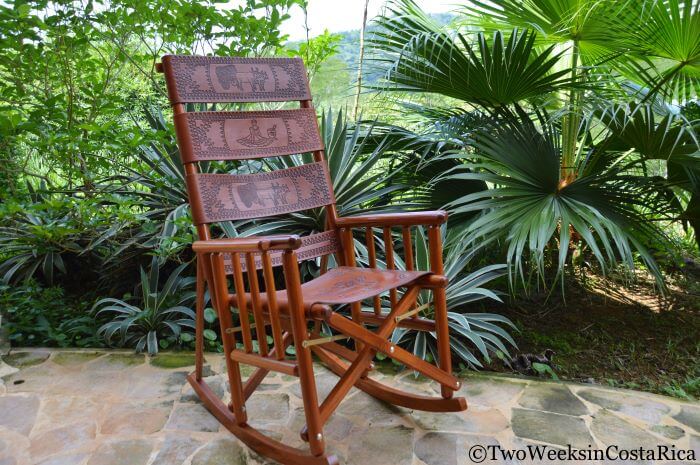
Location
Here is a map with the location of Fabrica de Carretas Eloy Alfaro.
Hours
Open daily, 7:00 a.m. to 5:00 p.m.
Cost
Free entrance & parking
Contact
For demonstration times or to set up a group tour visit, contact Fabrica de Carretas Eloy Alfaro directly through WhatsApp: +506 8824-3450
Conclusion
The oxcarts of Sarchi are definitely one of Costa Rica’s cultural treasures. We hope that you get a chance to visit the town of Sarchi to see these beautiful carts for yourself. If you have a free afternoon near the airport or are visiting the Poas Volcano area, Sarchi isn’t far away and is a great activity to add to your itinerary.
Have you visited Sarchi? Tell us what you thought in the comments below.
Looking for more info on this area of Costa Rica? Check out these posts:
How to Spend 1 or 2 Days in San Jose – If you want to explore Costa Rica’s rich history, be sure to make time for the museums in downtown San Jose. Here’s our guide for activities, restaurants, and hotels.
Best Hotels Near SJO Airport – Staying near the airport doesn’t mean you can’t enjoy yourself. See our picks for comfy places to stay that you might never want to leave.
La Paz Waterfall Gardens – Another popular day trip from San Jose are these wildlife exhibits and waterfall trails.
Atenas: A Glimpse of Authentic Costa Rica – Atenas makes a great home base if you’re looking to explore the many attractions of the Central Valley.
Things to Do in Costa Rica – Browse 150+ articles in our Activities category. We cover everything from historic sites to hanging bridge walks, national parks, boat tours, and more.


